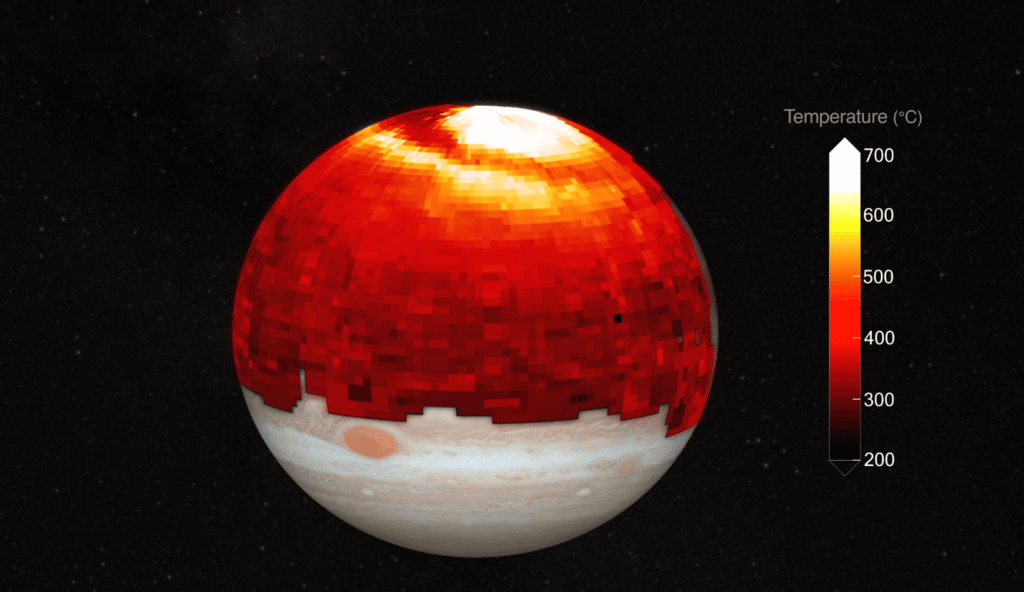Jupiter is a planet of extremes. Scientists now say that the planet’s upper atmosphere is much hotter than previously thought. A new study by the Japanese Aerospace Exploration Agency (JAXA) reveals that an unexpected “heat wave” of 1,292 degrees Fahrenheit extends 80,780 miles in Jupiter’s atmosphere.
Whereas typical poles of planets are usually cold, Jupiter’s is unusually hot and boiling with activity. JAXA shows that Jupiter’s upper-atmospheric weather is a lot more complex than believed — and it could help solve a problem that plagues research into the giant planets.
Jupiter is the fifth planet from the sun. It is the largest planet in our solar system, with a mass about 2 1/2 times of all the other planets combined. Its diameter is about 11 times that of Earth.
But if it’s farther away from the sun, why is Jupiter’s upper atmosphere hotter than expected?
Theoretically, its cloud tops should be a frigid -56 degrees Fahrenheit. But these clouds are going against the grain. Instead of being at temperatures below freezing, they’re actually hotter than 600 degrees Fahrenheit. How can that be?
Scientists are trying to figure out why the discrepancy exists.
Auroras are the glowing, colorful displays of light that occur on Earth when the planet’s magnetic field interacts with charged particles from the sun. But now, astronomers say that auroras can create much hotter temperatures than previously expected on another planet: Jupiter.
Jupiter has aurorae, too, but they are so powerful that they can heat the region around the planet’s poles to over 1,000 degrees Fahrenheit. That’s hot enough to melt aluminum bronze. Solar winds impacting the aurorae are the proposed and probable cause for this overexcitement at Jupiter’s poles. Even more astonishing is that these heat waves radiate toward the equator at thousands of miles per hour.
The aurorae deliver constant heat to the planet from the impacting solar winds. However, this additional heatwave event is unaccounted for so far in explanation. Theories abound ranging from models based on previous learnings to exploring whole new concepts of understanding.
JAXA’s Hisaki Spectroscopic Planet Observatory Satellite has been sending over data from one of Jupiter’s moons, Io, since 2013.
Jupiter’s polar region is white-hot while other colder regions are pictured as a dark red. The fast, rapid spinning of our solar system’s largest planet combined with its winds distributes the heat.
“Thanks to these maps, we demonstrated that Jupiter’s auroras were a possible mechanism that could explain these temperatures,” explains James O’Donoghue, planetary scientist, in a statement.
The discovery is exciting because it shows us how varied planetary atmospheres can be — even those we think we know well.
The satellite used to gather this information is the Juno (an acronym for Jupiter Near-Polar Orbiter) satellite made by Lockheed Martin and operated by NASA’s JPL (Jet Propulsion Laboratories). It’s a unique satellite in that it relies entirely on solar panels and batteries to function while previously and most popularly are RTG (Radioisotope Thermoelectric Generator) methods of propulsion.
Its mission is to gather as much as it can on Jupiter before it is intentionally deorbited into Jupiter’s atmosphere, its sacrifice is never in vain as scientists will even value data such as how quickly it disintegrates into the hellish gas giant’s clouds.














“Crisis”… What an idiot.